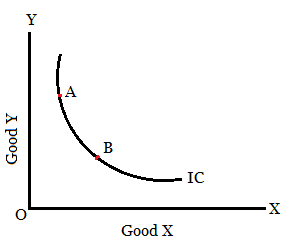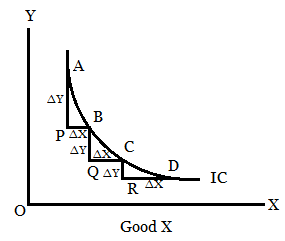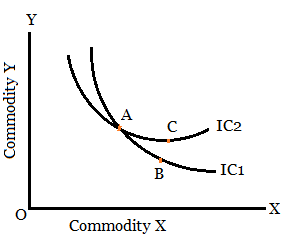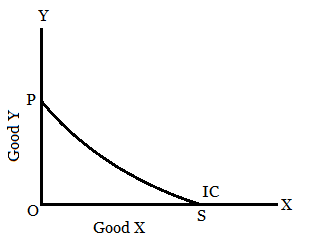Hi friends, in today’s article we are going to know about the attributes or characteristics or properties of indifference curve. So let’s discuss in details.
Table of Contents
What are the properties of Indifference curve?
The main attributes or characteristics or properties of indifference curve are as follows –
• Indifference Curves are Negatively Sloped – The indifference curves must slope downward from left to right. As the consumer increases the consumption of X commodity, he has to give up or sacrificed certain units of Y commodity in order to maintain the same level of satisfaction.

• Higher Indifference curve represents higher level of Satisfaction – Indifference curve that lies above and to the right of any other indifference curve represents a higher stage or level of satisfaction.
The aggregate of goods which lies on a higher indifference curve may be preferred by a purchaser or consumer to the combination which lies on a lower indifference curve.

• Indifference curves are Convex to the Origin
This is one of the important property of indifference curves. They are convex to the origin because the customer substitutes commodity X for commodity Y, the marginal fee or rate of substitution diminishes as X for Y alongside an indifference curve.
The slope of the curve is referred as the marginal rate of substitution. The marginal rate of substitution is the fee at which the customer have to sacrifice units of one commodity to gain one extra unit of another commodity.

In the above diagram, diminishing MRSxy is depicted as the consumer is giving AF>BQ>CR units of Y for PB = QC = RD units of X. Thus indifference curve is steeper in the direction of the Y axis and gradual in the direction of the X axis. It is convex to the origin.
• If the indifference curve is concave, MRSxy increases. It violets the fundamental feature of consumer behaviour.
• If commodities are almost perfect substitutes then MRSxy remains constant. In such cases the indifference curve is a straight line at an angle of 45° with either axis.
• If two commodities are perfect complements, the indifference curve will have a right angle.
In reality, commodities aren’t perfect substitutes or ideal enhances to every or each other. Therefore MRSxy usually diminishes.
• Indifference Curves can not intersect each Other
The most important properties of indifference curve are that two indifference curve neither touch each other nor do they cut each other.
In order to prove this, it may be supposed that two indifference curves IC1 and IC2 intersect each other at point A of the following figure –

∴ A = B —-(i)
Again, A and C are the two combinations who is lie on the same indifference curve IC2.
∴ A = C —–(ii)
According to the rule of transitivity if A = B and A = C then B = C. But this is not possible because combination C lies on a higher indifference curve IC2 and combination B lies on a lower indifference curve IC1.
Combination C should give grater satisfaction than combination B. This contradiction has occurred because our supposition was wrong and two indifference curves can not cut each other.
• Indifference curves do not touch the horizontal or Vertical Axis – One of the primary assumptions of indifference curves is that the consumer purchases combos of various commodities.
He isn’t always supposed to buy only one commodity. In that case indifference curve will contact or touch one axis. This violates the basic assumption of indifference curves.

FAQs
What is Marginal Rate of Substitution?
The Marginal Rate of Substitution is the fee at which the customer have to sacrifice units of one commodity to gain one extra unit of another commodity.
What is Indifference Curve?
Indifference curve refers to the graphical representation of various alternative combinations or bundles of two goods among which the consumer is indifferent.
Conclusion
So friends, this was the attributes or characteristics or properties of indifference curve. Hope you get the full details about it and hope you like this article.
If you like this article, share it with your friends and turn on the website Bell icon, so don’t miss any articles in the near future. Because we are bringing you such helpful articles every day. If you have any doubt about this article, you can comment us. Thank You!
Read More Article
• Derivation of Long Run Average Cost (LAC) Curve
• What is producer equilibrium? | Producer equilibrium class 11

